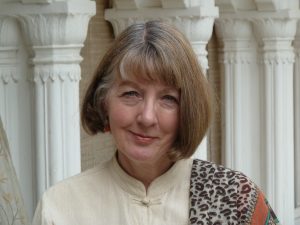By Clare Jenkins
 As a journalist, I’ve always written. I’ve also interviewed many writers, including Margaret Atwood, Melvyn Bragg, Jackie Collins, Margaret Drabble, PD James… When I interviewed Rumer Godden, who wrote wonderful novels about India, including Black Narcissus, she told me: “I was born with a gift for telling stories. It’s very seldom that two cultivated parents, themselves writers perhaps, have a writing child with a real gift. They may write very adequately but – and I’m not being rude to you – they’re journalists, not born writers.”
As a journalist, I’ve always written. I’ve also interviewed many writers, including Margaret Atwood, Melvyn Bragg, Jackie Collins, Margaret Drabble, PD James… When I interviewed Rumer Godden, who wrote wonderful novels about India, including Black Narcissus, she told me: “I was born with a gift for telling stories. It’s very seldom that two cultivated parents, themselves writers perhaps, have a writing child with a real gift. They may write very adequately but – and I’m not being rude to you – they’re journalists, not born writers.”
I took that one on the chin as, despite doing an MA in Creative Writing, I’m not a fiction writer. I majored in scriptwriting and wrote a pretty good radio play, but my strength is in non-fiction.
In addition to print journalism, I’ve written numerous radio documentary scripts, both for short features (for programmes like Woman’s Hour on Radio 4) and for half-hour doc-features.
One of the latter was Teatime At Peggy’s, broadcast on Radio 4 back in 2016 – https://www.bbc.co.uk/programmes/b05tpwc7. It encapsulated 15 trips to the central Indian town of Jhansi in Uttar Pradesh, where my travel writer husband Stephen McClarence and I became friendly with members of the town’s fast-dwindling Anglo-Indian community.
For background, Anglo-Indians are the mixed-race descendants of European (often British) men and Indian women. At the time of Indian Independence, there were around a million of them in India. However, after 1947, many emigrated to countries like America, Canada, Australia and the UK. As a result, they’re now designated a Minorities Community in India, with fewer than 150,000 left. I have an Anglo-Indian strand in my own family – my Great-Uncle William was a tea planter in Assam and had an Indian wife. So we knew a bit about Anglo-Indians but learnt a whole lot more during our visits to Jhansi.
The idea of turning the radio programme into a book came during lockdown. Every time we visited Jhansi, Steve – who wrote for The Times and Telegraph, among others – took copious notes and photographs, while I recorded interviews and conversations. Our main contacts were Peggy Cantem, the unofficial matriarch of the town’s Anglo-Indian community, and her old friend Captain Roy Abbott, possibly the last British landowner and farmer in India.
Although I used some of my recordings in the radio programme, they were just a fraction of what I’d gathered over the years. There was so much more to say about our experiences in Jhansi, our train journeys across India en route to Jhansi, and about the lives and rich histories of our Anglo-Indian friends. So in 2020 we decided to combine all the material we had and write a book together, a travel narrative cum social history.
So far so smooth. But as anyone who’s ever co-written a book will know, there will always be disagreements, as well as revelations, in the process. I’d already drafted a couple of chapters for my MA, in a very different style to Steve’s; more pared back and dialogue-heavy. So there was a lot of batting drafts back and forth between us, with discussions (and the odd argument) about the right balance of observation, description, dialogue and humour. Thankfully, we admire each other’s work and have always been each other’s first audience and editors, so we always managed to resolve our different approaches.
Nonetheless, though, we do have different working methods. One of mine is to retain all previous versions of my work, labelling them V1, V2, etc. Steve’s is to delete older versions as he goes along. So there were moments when we both became confused as to which version we were working from.
Another decision was over who would ‘own’ the narrative voice. We couldn’t write it in the plural. For me it was a no-brainer, Steve was the award-winning travel writer, so it’s written in his voice, though it’s very much a joint project.
Initially, the structure was purely chronological, based on our visits over the course of 17 years. However, for the Life Writing module on my MA, I’d written an account of a road accident outside our Jhansi hotel, which then led into our first meeting with Peggy and the start of our journey ‘down the rabbit hole’ into an Alice in Wonderland world of eccentric characters and richly ‘other’ experiences. It was so well received by the tutor and my fellow students that Steve and I agreed to start the book with that. As one of my brothers later said, “After I got past the bit about the cow licking up the pile of vomit, I was hooked…” (You can read this opener on Amazon – https://bit.ly/4dj2uTk)
When we finally found a publisher – Bradt Travel Guides – we were allocated a wonderful editor in Ross Dickinson. His editorial report started: This book was a joy to edit and went on to say: I love non-fiction which opens up a new world for me, and this did exactly that. I had no idea about who or what Anglo-Indians were, but now, after reading (and editing) this, I genuinely feel thoroughly enlightened about a group of people whose existence I had never even considered before.
He didn’t alter any paragraph or the overall structure of the book, admitting (boast alert!): Because it’s so beautifully written, the bulk of my work has been the standardisation of everything. I guess, because Steve and I are both journalists, we’re pretty practised at fact-checking, editing and proof-reading. There was still a fair bit of discussion in the editing process (and the occasional digging in of heels), but that was mainly connected to adapting to the publisher’s style guide. As journalists, for instance, we would always put single quotes inside double quotes. Bradt’s house style is the opposite.
Where descriptions were concerned – again, to quote Ross: The evocation of place is pitch-perfect – I could always picture every dining room and veranda. A lot of that detail is due to Steve’s assiduous note-taking. As we sat around Peggy’s table, talking to her and her friends, or went round to other people’s homes for ‘Mad Hatter’s tea parties’ involving cake and ‘small eats’, or travelled round India by train (usually in 2nd Class AC), he would make notes in a reporter’s notebook and then spend evenings expanding them in a journal. Also, because he’s an excellent photographer, we have hundreds and hundreds of photos – of people, places, mantelpieces, ornaments, stations and street scenes – we could refer back to.
If it all sounds like plain sailing, well, it wasn’t. The trouble (nightmare) came when the edited version was emailed to us and my computer immediately went on strike. Every time I tried to reply to one of Ross’s comments or make a further edit myself, the screen would go pale, the ‘circle of doom’ as a writer friend called it would whirl round, and the dreaded phrase: Word is not responding would appear.
I tried editing on Steve’s computer, but that meant taking it away from him and his other writing work. I tried on the laptop, but the amendments then appeared in a different format. At one point, all Ross’s comments dropped down by a page and were no longer linked to the words or phrases they referred to. In the end, driven to distraction by technology, we printed the manuscript out and edited it all by hand. And we sent the publisher both versions: the messy computer-amended version by email, the painstakingly hand-amended, printed-out version in the post. Thankfully, the final proof incorporated all the correct edits.
Now it’s published, we’re hugely proud of it. Like childbirth, we’ve forgotten the pain and relish the result. One five-star Amazon review said: It must become a classic, another called it: A fabulous read, someone else called it: A gem and various people have told us how, as with Ross, it’s opened their eyes to a world they knew nothing of, and which might yet disappear altogether.
Both Peggy and Roy have died since we wrote it, as have a couple of other people in the book. Their memories: of moonlight picnics in the jungle, May Queen and Monsoon Toad Balls, pet mongooses and Mulligatawny soup could have died with them. Instead, we hope that Teatime At Peggy’s captures at least a flavour of the extraordinary world of India’s Anglo-Indians.
*****
Teatime At Peggy’s: A Glimpse Of Anglo-India, is published by Bradt Travel Guides, price £9.99 paperback, Kindle edition £7.99.
Author bio:
A journalist, broadcaster and oral historian, Clare Jenkins was a regular contributor to Radio 4’s Woman’s Hour, including reporting on women’s lives in India. She has also made hundreds of features and documentaries for BBC Radio, including some from India. She has previously published books about women’s relationships with Roman Catholic priests, and people’s experiences of bereavement, and now writes travel articles and hotel and theatre reviews for On Yorkshire magazine: https://www.on-magazine.co.uk/tag/clare-jenkins/
Connect with Clare on X: @ClareJenkins13
You can hear great new ideas, creative work and writing tips on Write On! Audio. Find us on all major podcast platforms, including Apple and Google Podcasts and Spotify. Type Pen to Print into your browser and look for our logo, or find us on Podcasters.Spotify.com.
*****
If you or someone you know has been affected by issues covered in our pages, please see the relevant link below for information, advice and support: https://pentoprint.org/about/advice-support/





